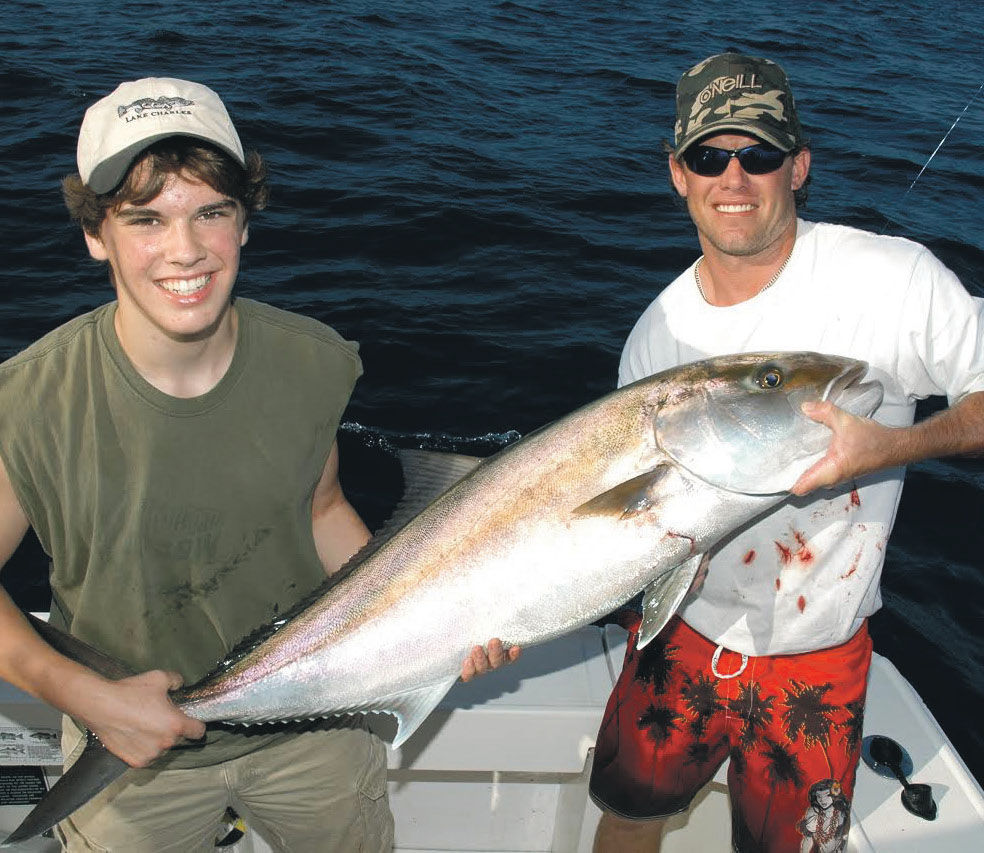
Lafourche Parish Sheriff Craig Webre walking tall
May 21, 2015Breaking: Platform fire in Gulf
May 22, 2015With incredible raw power, a deep-water leviathan inhaled the bait dangling nearly 300 feet below the surface and steadily pulled line from the big game reel as if a nuclear submarine tangled the straining braid.
“This is the biggest fish I’ve ever had on a line,” screamed Jen Carroll who used to fish professional women’s bass circuits. “I’m trying to get it in, but it’s not moving. It’s my workout for the week-two weeks-and what a workout!”
Cranking furiously on the big Penn reel, Jen regained two feet of line only to lose four to the monster from the deep even with maximum drag. Eventually, Jen subdued the beast weighing nearly as much as she did. After a lengthy battle in the Gulf of Mexico, she finally horsed one of the most powerful fish in the world to the surface.
“There are some monster amberjack in the gulf,” remarked Capt. Tommy Pellegrin of Custom Charters (985-851-3304, www.Customchartersllc.com) “Divers tell me they’ve seen amberjack in the 120-to 130-pound range with several hooks hanging out of their mouths. Sometimes, we hook something we can’t move. We call it a UFO, an Unidentified Fishy Object. Usually, that’s a big amberjack or grouper.”
Often compared to winching an anvil off the bottom, battling big amberjack can challenge just about any angler or tackle. When hooked, amberjack don’t display the flash of a king mackerel or speed of a tuna, but they exhibit incredible strength. Bill Weldon holds the Louisiana state record with a 139-pounder he caught in South Timbalier Block 300 in May 2009, but the world record topped 156 pounds.
“If people struggle to catch a 40-to 50-pound amberjack, think how much trouble they’d have fighting a fish with double that power,” explained Pellegrin who runs out of Boudreaux’s Marina (985-594-4568, www.boudreauxsmarina.net) in Cocodrie. “We catch bigger tuna and marlin because we have a lot of line and the fish are running away from structure into the open. An amberjack runs right to structure to cut the line. With the power of an amberjack swimming next to a rig, the chances of landing a 100-pounder are slim. To catch a monster amberjack next to a platform, use a reel with a welded drag that won’t give. Attach that
Q. What is a “caiman” (pronounced KI-MOA) or “cocodrie” (pronounced COCO-DREE)?
A. These are Louisiana Cajun French names for the alligator.
Q. What is a “caouane” (pronounced COW-AN)?
A. It is the Cajun French name for the alligator snapping turtle (freshwater), better known locally as a “loggerhead” because of the extremely large size of the head (circumference may reach up to 25 inches).
Q. How many species or different kinds of fish are there?
A. Scientists estimate that there are from 20,000 to 40,000 species of fish found on earth; many of these are still undiscovered!
Q. What is the world’s largest fish?
A. That would be the whale shark. Measuring in at over 50 feet long, it can weigh several tons.
Q. What is the world’s smallest fish?
A. Growing to less than 1/2 inch at adulthood, the goby (found in lakes in Luzon, Philippines) qualifies as the smallest fish currently known to man.
Q. How can they tell how old a fish is?
A. There are two methods commonly used to age fish. Growth rings are counted on either fish scales or otoliths (small inner ear bones) in a manner similar to counting rings in a tree. The rings generally correspond to seasonal changes in the environment. Otolith ring counts are generally more accurate than scale ring counts due to the fact that scale rings are often influenced by other, non-seasonal factors.
Q. How long do fish live?
A. Some small reef fishes live for only a few weeks or months, while other fish, such as sturgeons, have been known to live for 50 or more years.
Q. Is fish flesh very salty?
A. Actually, in most cases, the flesh offish contains very little salt. So little in fact, that many doctors recommend it in salt-free diets.
One exception though is the shark, whose meat is salty-as salty as the water in which it lives throughout the earth’s oceans and gulfs.
Q. Are saltwater catfish edible?
A. Absolutely! The two species found in U.S. waters, the gafftopsail catfish and the sea catfish (hardhead) are both good to eat, with the gafftopsail catfish considered the more delectable.
Do you have any fish and seafood mysteries that you’d like solved?
Do you know a fisheries-or seafood-related fact that others might find interesting?
If so, contact me and we’ll look into using it to add just a little more spice to our future fish and seafood trivia sauce.
Email your information to sports@rushing-media.com today.
‘There are some monster amberjack in the gulf. Divers tell me they’ve seen amberjack in the 120-to-130-pound range with several hooks hanging out of their mouths.’
Captain Tommy Pellegrin
Custom Charters
Steven Felsher and Dave Duncan show off an amberjack that Felsher caught during a recent trip. Cajun Sportsman Outdoors Guru John Felsher said that amberjack are always hitting in local waters, especially in Cocodrie. The time is now to snag the offshore fish, because the season takes a break beginning on June 1.












